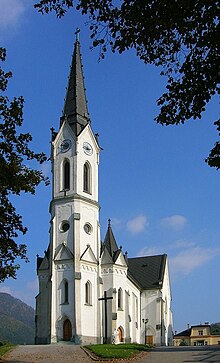Černová massacre
The Černová massacre or the Černová tragedy ( Slovak : Černovská masakra or Černovská tragédia , Hungarian : Csernovai tragédia ) was a massacre that took place on October 27, 1907 in the village of Černová (now part of Ružomberok ) in the Kingdom of Hungary .
On the orders of the local chief of the Royal Hungarian Gendarmerie Ján Ladiczky, his gendarmes shot at a gathered crowd of Slovak civilians demonstrating against the inauguration of the local Roman Catholic Church by a Hungarian priest instead of the Slovak Andrej Hlinka . 15 people - men, women and children between 14 and 55 years of age - were shot or died as a result of their injuries. Another 52 people were injured. The gendarmes themselves were also native Slovaks.
The Černová massacre drew international attention to the catastrophic national situation of the Slovaks and other non-Magyar peoples, who were exposed to the repressive Magyarization policy in the Hungarian part of the Austro-Hungarian monarchy . Former Hungarian Foreign Minister Géza Jeszenszky (1990–1994) judged the Černová massacre as the “turning point” after which, for example, in Great Britain, Hungary, which was previously “liberal”, began to be accused of “Russian despotism”.
On October 27, 1932, a memorial plaque for the victims of the massacre was unveiled in America in the presence of Andrej Hlinka, Milan Hodža , a Polish delegation and representatives of the Slovak League.
literature
- Karol Sidor : Černová (1907–1937). (Černovská masakra a pravota). Slovák / Nov. a nakl. úč. spol., Bratislava 1937.
Web links
- A detailed description of the events in Chapter XVII A Political Trial in Hungary and its sequel in: Seton-Watson, R .: Racial Problems in Hungary (English)
- Utonulý ve víně aneb noviny před sto lety, www.týden.cz, accessed on June 11, 2011 (Czech)
- Černovská masakra, www.cernova.sk (Slovak)
Individual evidence
- ^ Paul Lendvai: The Hungarians. A thousand years of history. Willhelm Goldmann Verlag, Munich 2001, p. 341
